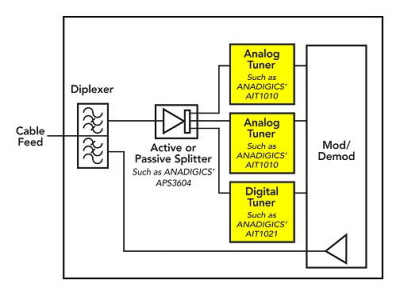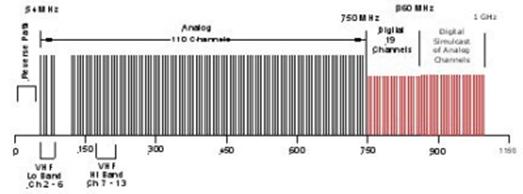Tag: CATV DVR
This article refers to the address: http://
For current cable TV service products, to transmit multimedia content, the STB is required to be equipped with more than one tuner. CATV set-top boxes (STBs) are experiencing dramatic growth as cable TV (CATV) operators expand their businesses into video-on-demand (VOD), pay-per-view, and digital content. In addition to providing analog video image reception, common STBs now support multiple functions, including personal video recording (PVR) / digital video recording (DVR), picture-in-picture, broadband VOD, telephony, digital video and high resolution. (HDTV) content.
The multimedia type currently offered by the cable TV service requires the STB to be equipped with more than one tuner. According to InStat's research, 38% of STBs provide PVR/DVR functionality in 2005, which means that many STBs currently in use have multiple tuners, typically with 1 or 2 analog video tuners and Figure 1. The digital data tuner shown in the block diagram. Basically, tuner manufacturers benefit from this growing demand, but outdated technology can't afford the work they do. In fact, new markets are forcing people to improve the performance specifications of tuners, requiring design engineers to redesign boards to develop highly integrated tuners using new methods and advanced process technologies. Finally, OEMs and subsystem manufacturers should not treat all tuners equally, but should carefully select the tuners and associated reference designs that are appropriate for their application.
Encapsulate more content into the cable spectrum
Compared to ever before, cable providers are increasingly packaging more services into the spectrum as they are pursuing the market leader in triple-play (voice, data and video) (Figure 2). Traditional tuners operate in the 50 to 860 MHz band, but people are planning to extend some CATV systems to 1 GHz. Therefore, the tuner now needs to have unprecedented performance, especially in terms of linearity, dynamic range and noise. But that's not the only thing, because OEMs have added the power of STBs, they need simpler, smaller designs to increase manufacturing efficiency and provide highly reliable products. This responsibility falls on the shoulders of the tuner manufacturers who provide the best technology, design and integration to meet OEM needs.

Figure 1: STB with multiple tuners for receiving analog and digital content

Figure 2: The TV spectrum requires the tuner to have channel selectivity and linearity to produce vivid and clear video images
Integration: from chipset to single package
Just a few years ago, the best tuner products were dual-conversion tuner chipsets, and the combination of these upconverters and downstream converters offered a low-cost, low-distortion, and integrated synthesizer. Each chip has an area of ​​6mm × 10mm. This kind of package has been used for many years in the industry, and the shipment has reached several hundred million. Recently, tuner manufacturers have made great improvements to these designs. The footprint of a single package is smaller than the footprint of any chip in the old chipset. A typical single package tuner has an area of ​​8 mm x 8 mm, but some are as small as 6 mm x 6 mm. As shown in the example of Figure 3, these devices combine up/down conversion and frequency synthesizers in a single package, combined with off-chip features used in the past, such as tuning varactors and gain control.
In the process of selecting a tuner, the key difference is the integration and design complexity of the tuning function. OEMs need to master the entire bill of materials (BOM) because the tuner varies with integration and manufacturing convenience and requires additional off-chip circuitry. For example, a tuner with a single-ended RF input does not require an expensive off-chip broadband balun. Before choosing a tuner, the OEM should ask such questions: Do you need an RF input filter? Is the downstream converter integrated after the IF amplifier? Is it equipped with on-chip RF and IF gain control, and enough to cancel the external gain control circuit? What is the cost of my entire BOM after the tuner?
Basic tuner requirements
For current CATV tuners, the most basic requirements are good channel selectivity, excellent signal integrity, and a simple design. They also support industry standards such as OpenCable and DOCSIS to meet the needs of the upcoming market. In addition, they are cost-effective to handle analog and digital video, digital data, and in some cases cable telephones. Currently, as more and more consumers receive content and edit it and store it on the hard disk for future viewing, it drives the demand for multiple tuner DVR/PVR STBs. To achieve these functions, the STB must incorporate a variety of analog and digital tuners and splitters that distribute the signal while maximizing signal integrity. Because STB's design includes multiple features, space savings are critical; highly integrated single-chip tuners are more attractive than discrete or multi-chip front-end solutions.
The growing demand for PVR/DVR STBs not only challenges the tuner design, but also provides a signal for each tuner with as little noise and distortion as possible. It is also desirable to not only distribute the RF input to several RF outputs for feeding into each tuner, but also to add independent gain control to these paths, which reduces or eliminates the difficulty of adjusting the inputs in the tuner. . Therefore, it is important to have an STB front-end RF splitter with excellent noise figure and linearity to ensure minimal signal degradation. Today, there are several products on the market that bring all of these benefits. The compact single-package active splitter from ANADIGICS is one of the best known, offering not only industry-leading noise figure and linearity, but also Gain control independent of the wide dynamic range of each tuner path.
Bright White Candles/velas/bougies .make of paraffin wax ,and stearic acid .
snow white and pure white color ,very bright quality holy brand candles .happy candles .OEM brand .
usually yellow color box packing ,red color box packing this packing more popular aslo the box can add shrink paper pack ,and 35g/pc 8x30box/ctn 36g /pc /
if any inquire pls tell me exact weight ,then I will offer you best price .welcome to visit my factory
and shipment in the 30days after get the depsoit .
Bright Candle,Bright Different Colors Candle,Bright Birthday Candle,Ultra Bright Led Candle
Shijiazhuang Zhongya Candle Co,. Ltd. , https://www.zycandlefactory.com